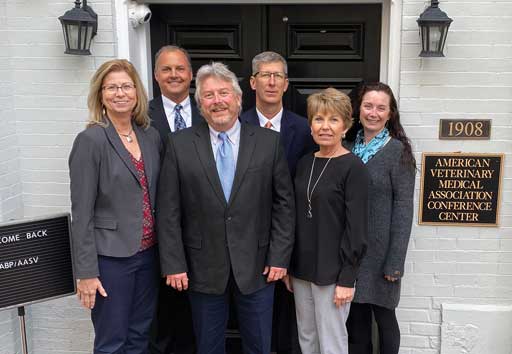Every 5 years, the US Congress passes the “Farm Bill,” a food and agriculture focused legislative package. The legislation includes new programs and programs that must be reauthorized every 5 years to stay in effect.
The majority of Farm Bill funding goes to key federal nutrition and food programs. Only about 1% of Farm Bill funds are divided among 8 program areas, including livestock health. In the 2018 Farm Bill, those combined programs accounted for only about $5 billion of the $428 billion total Farm Bill package. The next Farm Bill is expected to top $1 trillion, with over 80% devoted to the nutrition title.
Although a small portion of the total package, livestock health programs funded through the Farm Bill are critical for swine health and welfare, foreign animal disease (FAD) preparedness and prevention, and protecting the food supply.
Swine veterinarians are all too familiar with the FAD threat looming over the US swine herd and the severe consequences of an introduction. A successful response to an intentional or unintentional FAD incursion includes early detection, prevention, and rapid response tools; robust laboratory capacity for surveillance; and a viable stockpile of vaccine.
The critically important programs listed below were funded under Title 7, Chapter 109, Section 8308a of the 2018 Farm Bill. These remain critical programs and are Farm Bill priorities for swine veterinarians and pork producers.
• National Animal Vaccine and Veterinary Countermeasures Bank (NAVVCB) – Established in the 2018 Farm Bill, the US-only vaccine bank allows the US Department of Agriculture (USDA) to stockpile animal vaccine and related products to use in the event of an outbreak of foot-and-mouth disease or other high-impact FADs. The bank ensures that vaccines are available for rapid response.
• National Animal Health Laboratory Network (NAHLN) – The NAHLN is a network of over 60 federal, state, and university-associated animal health laboratories that provides rapid detection and response to endemic or emerging diseases. The laboratory capacity of the NAHLN is critical to ensuring that the United States can rapidly and effectively respond to a large-scale animal disease outbreak. Enhancing animal health diagnostic testing for both endemic and high-consequence pathogens in the nation’s food animals is vital to protecting animal health, public health, and the nation’s food supply. These laboratories are the first line of defense for detecting animal diseases and pathogens. Diagnosing and detecting the extent of an outbreak as rapidly as possible plays a key role in response.
• National Animal Disease Preparedness and Response Program (NADPRP) - This program allows USDA Animal Plant Health Inspection Service to collaborate with animal health partners throughout the nation to implement high-value projects that enhance prevention, preparedness, detection, and response to the most damaging emerging and FADs that threaten US agriculture. The AASV received NADPRP funding in 2021 to review and update the AASV Recommendations for the Depopulation of Swine to incorporate the results from the research studies and field trials and the first-hand knowledge gained through the COVID-19 market disruption.
• National Veterinary Stockpile (NVS) – The NVS provides the veterinary countermeasures (animal vaccines, antivirals, or therapeutic products, supplies, equipment, and response support services) needed to respond to animal disease outbreaks. Sampling, vaccination, and depop-ulation equipment are critical to a response’s success. The NVS should be well-supplied to support states, tribes, or territories when needed.
Other areas or programs animal health and pork stakeholders are advocating for include catastrophic insurance through USDA, eradication and control of feral swine, and the Food Animal Residue Avoidance Databank.

The AASV advocates for swine veterinarians and animal health by providing scientific information to support these priorities. The AASV Executive Committee, Drs Mike Senn, Bill Hollis, Mary Battrell, and Angela Baysinger, with AASV staff Drs Harry Snelson and Abbey Canon, visited Washington D.C. in May 2022 to introduce some of these priorities to policy makers with members of the American Association of Bovine Practitioners and the American Veterinary Medical Association. Additionally, AASV member veterinarians who have participated in the AASV/National Pork Producers Swine Veterinarian Public Policy Advocacy Program will be back on Capitol Hill in 2023 to emphasize these priorities and explain their impact.
All veterinarians and pork producers have the opportunity to advocate for animal health and welfare during the upcoming Farm Bill discussions by sharing their stories. Your personal story has impact. Describe who you are, who you represent, how this topic affects you, your practice, the animals under your care, the food you help produce, and the clients for whom you work.1
Now is the time to introduce yourself to your legislative representatives. Offer to be a resource, provide science-based information, and describe the impact to swine medicine. Consider offering your representative the opportunity to ride along with you to understand and experience veterinary medicine and swine production.2 Participate in the NPPC fly-in or AVMA legislative fly-in that brings veterinarians to Washington D.C. to meet with their members of Congress.3
You can help carve out that small piece of the pie that has a big impact on animal health and welfare. For more information on swine-specific Farm Bill priorities, visit nppc.org.
Abbey Canon, DVM, MPH, DACVPM
Director of Public Health and Communications
References
*1. Canon A. Empowering you to advocate. [editorial]. J Swine Health Prod. 2021;29(4):219.
*2. American Veterinary Medical Association. Come one, come all: Member power in AVMA advocacy. AVMA Axon. 2020.
*3. American Veterinary Medical Association. Get Involved. AVMA. Accessed May 2021. https://www.avma.org/advocacy/get-involved
* Non-refereed references.
